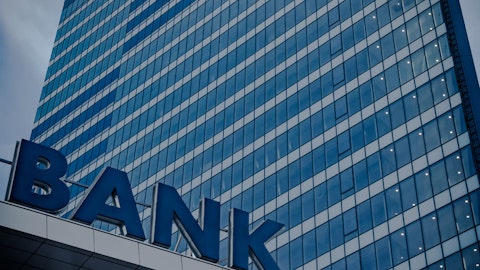We’re going to grow NII this year, 3% to 5%. Others are shrinking. So our philosophy is paying off in the real world. The challenge simply comes from the fair value of a single line item and putting that into capital. We’re not insensitive to how that looks on the face of the balance sheet and the tangible book value per share. But we still believe it is prudent to have that flexibility because flexibility has value. In terms of the regulatory risk, perhaps one of the details that we continue to evaluate as something we’ve not really communicated to all of you externally, is that given the burn down that you have in the presentation and the significant, whether it’s static rate, forward rate, you’re looking at 60%, 65% of the ASC burn down during the transition into the new capital regimes, assuming the rules play out as currently written, and that burn down is going to happen on our portfolio because our portfolio has structured.
We have defined maturities unlike those portfolios that are in residential mortgage-backed, instruments with convexity and extension risk, we know our portfolio is going to pay down. And we know that this is going to be very manageable from a regulatory capital perspective. When we model the capital impact at a fully phased-in level on AOCI, the impact on CET1 is about 125 basis points when you reach the third quarter of 2028 and that’s why we continue to accrete CET1 is to be able to have sufficient regulatory capital for that world. And in fact, should rates get north of 8%. We would still be maintaining a CET1 well above regulatory minimums would be over 8% CET1 in that environment. So we feel good about how we’re positioned, how we will roll down the curve and ultimately, the regulatory capital.
It’s just one of the challenges in this environment with everything in AFS is that you have that mark on the tangible book value per share, that erosion. But at the same time, should rates fall. I think all of you would be very pleased with how much tangible book value accretion, we would report in that environment.
TimothySpence: And Scott, if I just put a point on the last thing, Jamie you said. I mean, we believe investors want us to do what is best for managing the business and for recognizing the fact that options have value but if you believe that the AOCI mark is weighing on the stock, then the other way to look at it is the burn down is 25% accretion in tangible book value per share in the next two years, just given the current outlook on rates, which is a pretty unique buying opportunity, be the other way to look at it.
ScottSiefers: Yes, I agree. All right. That’s perfect. So Tim and Jamie, thank you both.
Operator: And your next question comes from the line of Erika Najarian from UBS.
ErikaNajarian: Jamie, this first one is for you. Not to belabor the earlier point, but all the PPNR metrics and balance sheet metrics look great and also did the forward look? And I guess, if you could just explain what happened in the quarter, I think given that your portfolio — your securities portfolio is 61% CMBS. I think investors that know you well, expected not as much negative convexity — was there something unique that happened in this quarter in the portfolio that — where the AOCI was that much wider?
JamesLeonard: Not really. It was a pretty vanilla quarter for us where we had cash flows in the quarter of about $500 million. We put about $700 million to work of the excess cash in short duration Level 1 treasury floaters. When you look at the AOCI walk that happened in the quarter, the securities portfolio because everything is in AFS, worsened about $1.2 billion and if you look at how the 5-year move increased about 45 basis points, the 10-year moved to about 75% and then spreads widen 5 bps on the CMBS and about 15 bps in mortgage. So when you add it all up with the DV01 of about $25 million, that gets you to the AOCI movement for the quarter on the investment portfolio. And so it was in line at least with our expectations with how rates were moving during the quarter.





